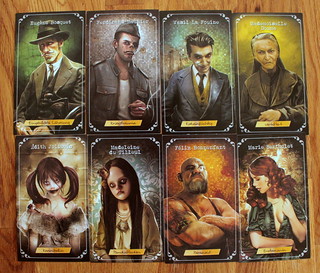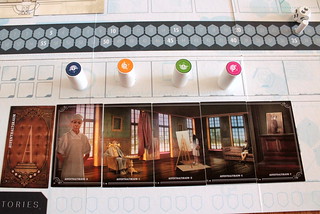| Strategy | Luck |
|---|---|
| Interaction | Components & Design |
| Complexity | Score |

That is the idea behind T.I.M.E. Stories, a cooperative game by Space Cowboys. The players are time agents, sent back to protect the timeline. T.I.M.E. Stories is another approach to making games with a limited amount of replayability. The box contains, among other components, a deck of card that is the case to solve. You will play with that deck, and you’ll probably fail. Then you’ll play with the same deck again, preferably with all the same players, and you’ll remember things from the first run, so you’ll avoid some of your mistakes and make new ones. If you fail again, they’ll send you back again, complaining loudly about the cost of doing so, until you crack the case. At that point, playing through the same case again becomes pointless, you know how to solve it now. You can get new cases to solve as expansions, but this one is over. The system is different from the Legacy system used by Risk and Pandemic, though. Both systems give you a game that has a limited number of plays, right from the start. But where the Legacy games make you change the game and make it unusable when you’re through, T.I.M.E. Stories only changes your knowledge of the game. When you’re done, you give it your friends and watch them play and fall into the same traps that you did – and anxiously wait to see if they do better than you. Just for the record, in our case we could also drop the game into a baboon cage and watch them do better than us …
T.I.M.E. Stories is pretty light on the mechanics. Players explore a place of which they have a map right from the start. There are a number of locations in that place and the players always enter one of them as a group. When they do, they find the cards in the deck to lay out the panorama for that location, a long image of the location spanning a number of cards. Then each player pick one of those cards to examine. Here they can split and team up any way they like. Players examining a card may turn it over and read the text on the back. Some are really just descriptive with lots of flavor, but others bring the actions. Some make you roll skill checks, others just want you to make a decision and some just hand you information you may or may not need later. You may acquire items to use later in your adventure, or you may turn over hidden cards from the current location to further the plot. As an example that is not from the case, you may examine a wardrobe. On turning the card you see that you may attempt a dexterity check to pick the lock. After you succeed you’ll be allowed to turn a hidden card from the location and discover what’s inside.

Rolling checks, examining things and walking from one location to the next all cost you time, and that’s a limited resource. When you run out of time you are transferred back to the headquarters, your mission failed, the game is over. You may try again in a new game.Time being limited as it is, here’s one piece of advice I can give you without spoiling the experience for you: the instinct to explore every last corner that you may have acquired in video games and RPGs is not helpful here, if you have a way to complete the mission go for it.
And that’s pretty much everything you need to know about the rules already, but a lot remains to be said about the scenario included with the game: Asylum. This is once again a game where I can’t tell you too much because of spoilers, but here is what I can tell you: the case takes you into an early 20th century insane asylum where, in some way, the future is at risk. You slip into the bodies of some of the inmates and get to work saving the world. I obviously can’t tell you what happens, but the story is dense and thrilling, a narrative experience that gets close to a role playing game. The art does a great job invoking the atmosphere and the ever-ticking clock gives you a strong sense of urgency.
But all that doesn’t change the basic fact that there is a limited amount of time you can spend with T.I.M.E. Stories, and if you don’t factor it the expansions then it’s much less time than Pandemic Legacy, for instance. You have to ask yourself it it’s worth spending money on. On the one hand you only have a few hours of fun with each scenario. On the other hand, unlike the Legacy games, you can share a copy with friends and they can have fun with it as well. After trying it, what makes the decision for me is this: T.I.M.E. Stories is maybe the most immersive board game I have ever tried. That obviously depends on the scenario, but the Asylum really drew me in and made me feel like I was there, it was a great experience. And voices on the Internet say that The Marcy Case, another scenario that is already available, is even better.
T.I.M.E. Stories seems like an attempt to create a subscription type model for boardgames. As long as you keep paying, you can keep enjoying it. After the first case I’m completely hooked. Consider me subscribed.















